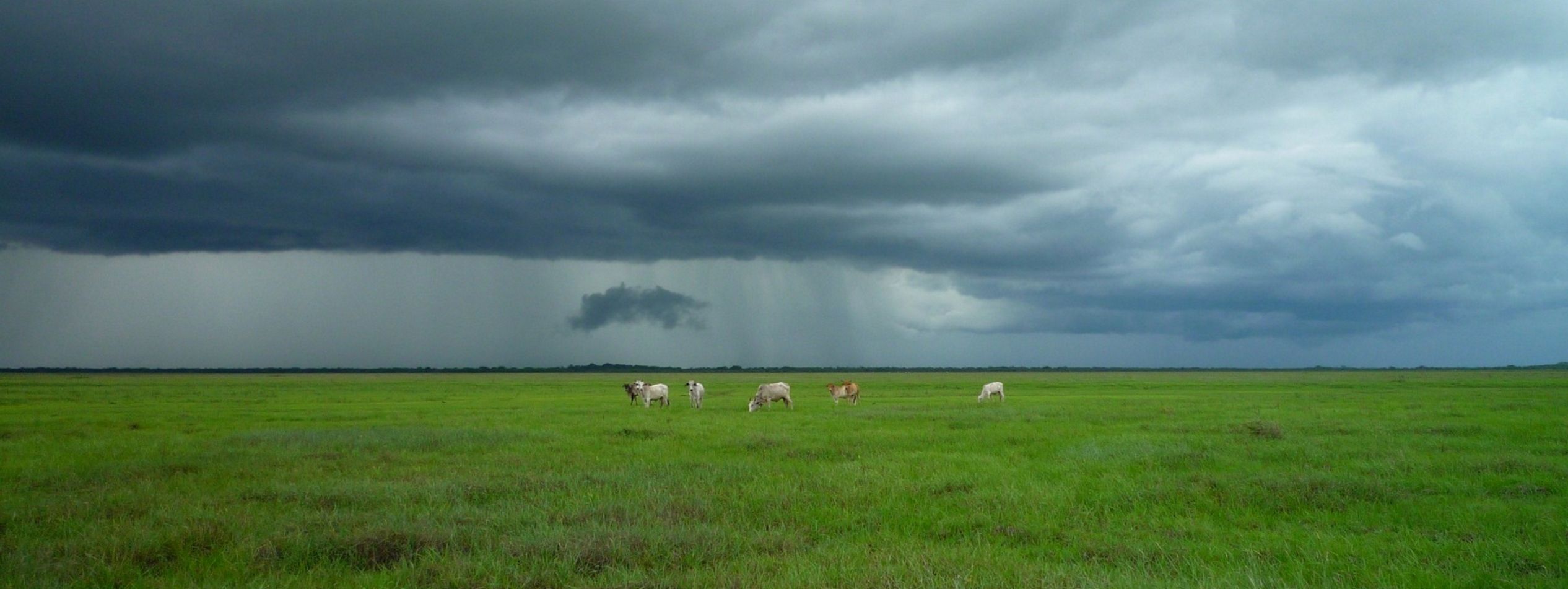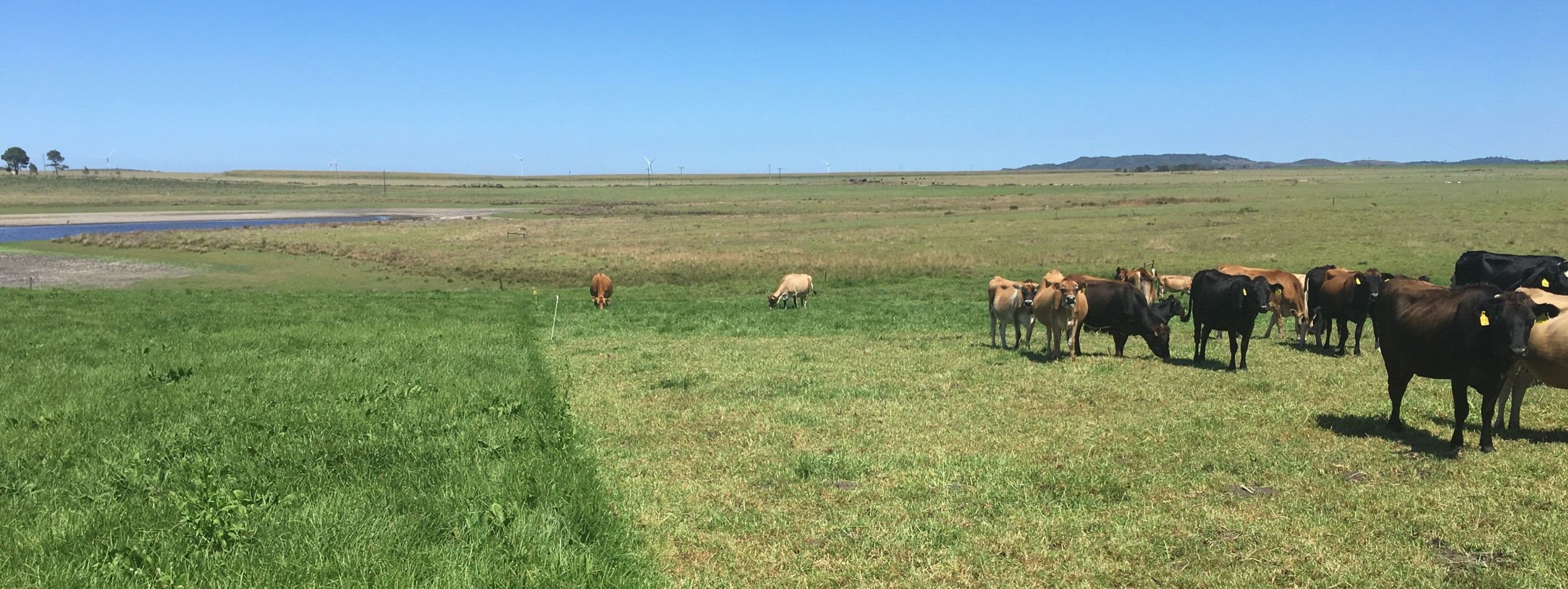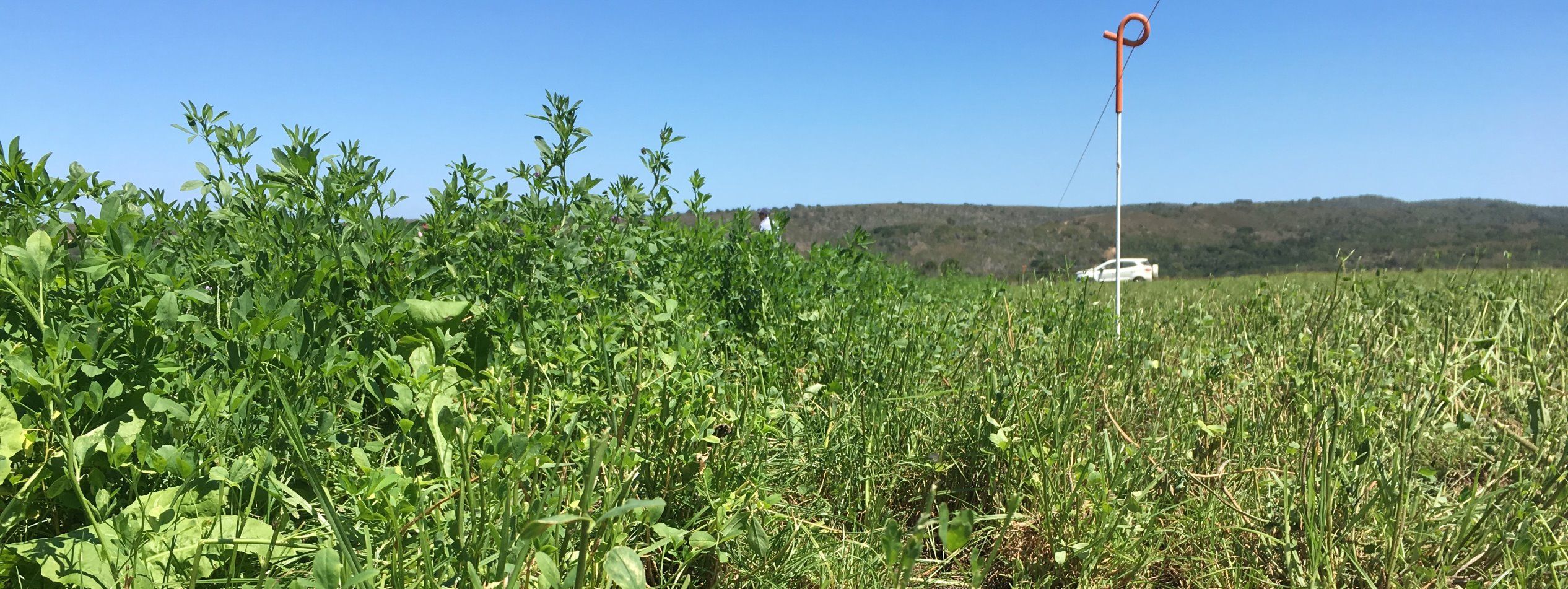One of the major aspects of livestock farming is obviously keeping the livestock fed so as to ensure the animals are kept healthy and remain productive. On pasture-based farms (e.g. dairy and beef farms), the roughage grown on pastures is the predominant feed source. It is therefore most beneficial to grow and utilise these pastures effectively. The distinction is made in this article between extensive rangeland grazing, and intensive pasture grazing. Extensive rangeland grazing is where large areas of predominantly natural grassland are grazed by livestock for long periods of time. This includes neither the intensive management of the growth of the grass, nor intensive management of the livestock grazing. Intensive pasture grazing is where livestock are actively managed to graze areas of predominantly cultivated pasture, which have been actively managed to maximise pasture growth. This article only deals with intensive pasture grazing management.
We often speak about good pasture and grazing management, but what exactly does this mean? There are a few basic principles which constitute good, sustainable rotational grazing management. If you follow these principles you will grow and utilise your pasture more effectively and improve the health of your soil (Read how here: Photosynthesis – the true source of soil carbon). It must be noted that these are only principles though, and in the end, the most effective way to manage pastures well is to be in your pastures as often as possible, observing how they respond to various management practices and climatic conditions. The more you get to know your pastures, the better you will be able to manage them.
There are two main components to effective pasture and grazing management. Firstly, the growth of sufficient, good quality pasture, and secondly the effective utilisation of these pastures through good grazing management. When done correctly the two directly complement each other, as effective grazing management actually contributes to the improvement of soil health, which contributes to the growth of sufficient, good quality pasture. The most prominent example of this is that allowing pastures to grow for long enough periods of time between grazing events helps to build organic matter in the soil through root growth. This causes an increase in the soil carbon levels which contributes to better water and nutrient holding capacity, more microbial activity and improved structure, all of which will contribute to better pasture growth. The main focus of this article is on the second component of grazing management, but the first component will be briefly discussed first.
1) Growth of sufficient, good quality pasture
This component is about meeting the nutritional requirement of the animal. Pasture growth is influenced by numerous factors, which include temperature, soil moisture, sunlight, the degree to which plants are defoliated and the availability of nutrients in soil. There are only three of these which can be directly influenced by a farmer. Soil moisture is influenced by rainfall, but also, where possible, through irrigation management. The degree to which plants are defoliated is influenced by grazing management, and is discussed in detail below. The availability of nutrients is influenced through soil health management.
Irrigation management is a critical aspect of ensuring optimal soil moisture levels. Where and when irrigation water is readily available, irrigation scheduling and management principles should be followed to both optimise water use and pasture growth.
Soil health management is an important aspect of growing sufficient and good quality pasture. There is an obvious and direct link between pasture growth and soil health, as healthy soil is the starting point of healthy crops. Soil health testing helps to identify areas where there is lack or imbalances in the soil which will limit the growth of good quality pasture. Actions should be taken according to these opportunities and limitations identified through the soil health testing process. For example, if there is a deficiency in potassium, a form of potassium fertiliser should be applied, or if there is a compaction problem, this should be addressed. Grass samples can also assist in identifying any lack or imbalance of nutrients in the pasture.
2) The effective utilisation of pastures
The effective utilisation of pastures is about ensuring that the grass which is grown on the farm is turned into production, be that in weight gain or milk production. It is one thing to grow sufficient and good quality pasture, but another to ensure that this is utilised effectively. The pasture grazing management principles discussed below are how effective utilisation of pasture can be achieved.
The basic principles of good pasture grazing management are:
- Planning
- Know what you aim to achieve through grazing management. Traditional best management practices focussed predominantly on animal-related parameters, whereas more recently, a combination of animal-related, plant-related and soil-related parameters have been taken into account.
- Use the principles mentioned below to work out the rotation, and formulate a plan for how to stick to this rotation.
- Know your pasture growth, and whether it is currently sufficient, too low or higher than your feed demand at the current stocking rate. Whichever of these it is will mean you have to approach the current situation accordingly.
- Weekly farm walks are a must, and inform decision-making – you can’t manage what you don’t measure. Average pasture cover should be measured and calculated after your weekly pasture walk.
- Use the available technology to assist you, for example a feed wedge.
- At times, it might be necessary to feed supplementary roughage, so as to maintain the grazing rotation which achieves your goals. Planning should be done accordingly, as without sufficient foresight, your grazing strategy can quickly be thrown out the window in favour of just trying to get animals fed.
- Periods of surplus pasture should also be planned for, knowing when areas should be removed from the rotation in order to make conserved feed.
- Equipment and setup
- In order to implement a rotational grazing management strategy, it is important that you have the necessary setup on your farm.
- This includes, for example, ensuring that you have water troughs in appropriate locations, that you have an electric fences system which will assist in daily pasture allocations, and that you have technology and computer programs that can assist you.
- It is also important that you have an accurate farm map, with accurate camp sizes, which will assist you in planning and executing your grazing management plan.
- Rotation
- This is the length of time required to make one complete cycle of the pasture in a grazing unit, also referred to as grazing cycle.
- It is important to stick to a pasture rotation that achieves quality pasture, the full utilisation of pasture grown and ensures building soil health.
- By consistently managing pasture rotation according to the correct principles, you can ensure the maximum harvesting of sunlight, the minimum decay of leaves, the maximum growth of roots and a high quality of pasture.
- The rotation length should change between seasons, relative to the factors which influence pasture growth. Working out the rotation is adaptive, and is a weekly thing, not just a once off thing.
- Pastures should not be left for too long between grazing events as when the grass gets too long the top leaves shade the initial leaves grown. This is called canopy closure and causes these leaves to deteriorate, meaning a decrease in pasture quality. Irrespective of other factors, a pasture which reaches canopy closure should be grazed or mowed for conserved feed as soon as possible.
- Pastures should not be grazed too soon, as this will result in the removal of nutrients, especially carbon, from the soil, instead of the transfer of nutrients from the leaf to the soil – which happens when there is large enough leaf area to support sufficient photosynthesis for vegetative growth and root growth.
- Most basically the pasture rotation can be based on the growth rate relative to the amount of pasture allocated per hectare. For example, when aiming to allocate 1000 kg/ha, and the current growth rate is 40 kg/ha/day, then the rotation would ideally be 25 days.
- The regrowth of most pasture grasses after grazing follows an S-shaped curve. This means that during the initial recovery phase, the growth is slow, followed by a phase of high, exponential growth, after which follows a decline in growth rate. These phases of pasture growth have been shown to be closely associated with the number of leaves that are grown. In ryegrass, the emergence of the first leaf is associated with the first phase, with the decline in growth happening after the third leaf has been fully grown. Ryegrass pastures should therefore ideally only be grazed at the 3-leaf stage. Leaf stage is another tool which farmers can use to determine the rotation length, along with the other principles discussed. It is important to find out the ideal leaf stage to graze the grass species occurring in your pasture. The rise in popularity of multispecies pastures has made basing pasture rotation on leaf stage more complicated, as the different pasture species have different leaf emergence rates.
- Allocation and utilisation
- Once the pasture rotation has been determined, it is important that the correct area is allocated for grazing.
- As discussed in the planning section, you should know the current growth rate and available pasture which you can allocate on the farm.
- It is important to know the feed requirement of your livestock, so as to know what area to allocate to what number of livestock in order to meet your feed demand. This is both on a whole-year basis, as in knowing the correct stocking rate for the farm, based on the carrying capacity, as well as for each rotation.
- If a farm is overstocked, then the rotation dictated by the principles discussed above will result in the area allocated each day being insufficient to support your feed demand without significant, costly supplementary roughage and concentrates.
- If the farm is understocked, then the pasture grown on the farm will not be fully utilised.
- Effective allocation, which results in effective pasture utilisation, is directly linked to knowing what supplementary roughages and concentrates need to be fed to compliment pasture in order to meet the daily energy requirement of the animal.
- If animals are overfed on roughage and concentrates, they will not fully utilise the allocated pasture. If animals are not provided sufficient supplementary feed, they will overgraze and/or under-produce.
- Post-grazing residual
- Post-grazing residual is the grass left on the pasture after grazing.
- It is important to maintain the correct post-grazing residual of around 1500-1800 kg dry matter per hectare.
- This is important because on the one hand, residual grass is not of good quality (livestock will only willingly eat what was grown since the previous grazing), and therefore if the residual continuously increases and an animal is forced to graze into it, it will result in lower production. On the other hand it is also important to leave adequate residual to support pasture regrowth and ensure that soil is never left bare.
- By attaining correct post-grazing residuals, pasture utilisation will be maximised and optimal pasture regrowth and quality will be achieved.
- Attaining the correct post-grazing residual is based on accurate pasture allocation, full pasture utilisation and taking corrective action when necessary.
- Corrective action includes using followers to ensure full pasture utilisation or mulching to the desired residual height.
- Assess and adapt
- It is important that you continually assess your grazing management strategy and implementation. There are a few indicators which can help you to ensure that you are on the right track.
- Before grazing, check that the amount of grass calculated to be available is actually available for the livestock to eat.
- After grazing, check that the amount of grass allocated was fully utilised, especially checking if the desired post-grazing residual height has been attained.
- The most important indicator of good grazing management is whether the level of production aimed for on the farm is being achieved, for example, is the pasture turning into milk in the tank, or are the livestock gaining the adequate weight.
- If any of these checks do not add up, then adjustments have to be made to the current management practices.
Good pasture and grazing management are central to sustainable pasture-based farming. The principles discussed in this article are basic principles which, if followed, will result in more effective pasture utilisation. This will contribute to a more efficient and therefore more profitable farm.
- A carbon footprint assessment for pasture-based dairy farming systems in South Africa - 2024-02-07
- What progress have farms participating with Trace & Save made over the past 10 years? - 2023-09-06
- Carbon footprint reduction over time: Lessons from pasture-based dairy farms in South Africa - 2023-09-04




